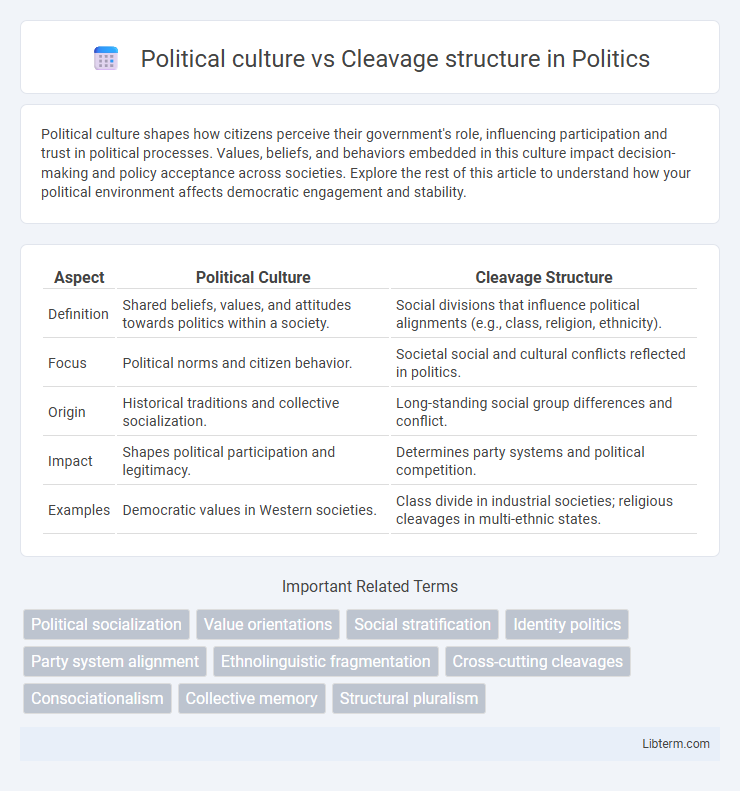Political culture shapes how citizens perceive their government's role, influencing participation and trust in political processes. Values, beliefs, and behaviors embedded in this culture impact decision-making and policy acceptance across societies. Explore the rest of this article to understand how your political environment affects democratic engagement and stability.
Table of Comparison
| Aspect | Political Culture | Cleavage Structure |
|---|---|---|
| Definition | Shared beliefs, values, and attitudes towards politics within a society. | Social divisions that influence political alignments (e.g., class, religion, ethnicity). |
| Focus | Political norms and citizen behavior. | Societal social and cultural conflicts reflected in politics. |
| Origin | Historical traditions and collective socialization. | Long-standing social group differences and conflict. |
| Impact | Shapes political participation and legitimacy. | Determines party systems and political competition. |
| Examples | Democratic values in Western societies. | Class divide in industrial societies; religious cleavages in multi-ethnic states. |
Introduction to Political Culture and Cleavage Structure
Political culture encompasses the collective attitudes, values, and beliefs shaping citizen behavior and political processes within a society, influencing stability and policy preferences. Cleavage structure refers to the deep-rooted social divisions, such as class, religion, ethnicity, and regional identities, that organize political alignment and party systems. Understanding the interaction between political culture and cleavage structure reveals how societal values intersect with group-based conflicts to shape political dynamics and voter behavior.
Defining Political Culture: Key Concepts
Political culture encompasses the shared beliefs, values, and attitudes that shape citizens' political behavior and system legitimacy. Cleavage structure refers to the deep societal divisions--such as class, religion, or ethnicity--that influence political alignment and party formation. Understanding political culture requires analyzing these cleavages as they frame collective identities and inform political participation patterns.
Cleavage Structure: Meaning and Relevance
Cleavage structure refers to the deep divisions within a society based on factors such as religion, ethnicity, social class, or language, shaping political alignments and party systems. These cleavages influence voter behavior, political mobilization, and policy preferences by creating enduring group identities that impact electoral outcomes. Understanding cleavage structures is crucial for analyzing political stability, representation, and the dynamics of conflict or consensus within diverse societies.
Historical Context of Political Culture and Cleavages
The historical context of political culture shapes the collective values, beliefs, and norms that influence political behavior and institutional trust within a society. Cleavage structures, rooted in long-standing social divisions such as class, religion, ethnicity, or language, emerge from these historical experiences and define group-based political competition. Understanding the evolution of political culture alongside persistent cleavages reveals how historical conflicts and alliances continue to inform contemporary political alignments and party systems.
Major Theories Explaining Political Cleavages
Major theories explaining political cleavages emphasize the role of socio-economic divisions, cultural differences, and historical contexts in shaping group identities and political alignments. Lipset and Rokkan's cleavage theory identifies critical divisions such as center-periphery, state-church, land-industry, and worker-employer as foundational to party system development and voter behavior. These cleavages persist through political culture, influencing value systems, political trust, and participation, thereby maintaining the stability or transformation of political institutions.
Distinguishing Political Culture from Cleavage Structure
Political culture refers to the shared values, beliefs, and norms that shape citizens' political behavior and attitudes within a society, while cleavage structure represents the enduring social divisions--such as class, religion, or ethnicity--that influence political alignment and party systems. Unlike cleavage structures, which categorize groups based on socio-economic or identity-based disparities, political culture centers on collective political orientations and symbolic meanings that transcend specific group identities. Understanding the distinction between these concepts is crucial for analyzing how social divisions translate into political behavior and institutional arrangements.
Interplay Between Political Culture and Cleavage Structure
Political culture shapes citizens' values and beliefs, heavily influencing how cleavages such as class, religion, or ethnicity manifest within a society. The cleavage structure, defined by persistent social divisions, interacts with political culture by reinforcing or challenging dominant norms and political behavior patterns. This interplay determines political mobilization, party systems, and policy outcomes, highlighting the dynamic relationship between cultural orientations and social group divisions.
Case Studies: Political Culture and Cleavages in Practice
Case studies of political culture and cleavage structure reveal how societal divisions influence political behavior and party systems in specific contexts. For example, in Belgium, linguistic cleavage between Dutch-speaking Flanders and French-speaking Wallonia shapes political party competition and governance dynamics. Similarly, India's caste-based cleavages interact with regional political cultures, affecting electoral outcomes and policy priorities.
Impact on Party Systems and Electoral Behavior
Political culture shapes the foundational attitudes and values that influence voter behavior and party allegiance, while cleavage structures--such as class, religion, or ethnicity--create distinct social divisions that political parties often represent. The interaction between political culture and cleavage structures determines the stability and fragmentation of party systems, affecting whether political competition is polarized or consensual. Electoral behavior is heavily impacted by how parties align with these cleavages, as voters tend to support parties that reflect their social identities and cultural orientations.
Future Trends in Political Culture and Cleavage Analysis
Future trends in political culture indicate an increasing polarization driven by digital media and social fragmentation, intensifying existing social cleavages such as class, ethnicity, and ideology. Emerging cleavage structures are expected to shift from traditional economic divides toward identity-based conflicts, including race, gender, and environmental concerns. Politicians and policymakers must adapt to these evolving cleavages by addressing diversified voter demands and leveraging data analytics for targeted engagement.
Political culture Infographic

 libterm.com
libterm.com